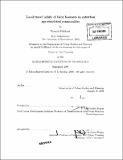Local travel habits of baby boomers in suburban age-restricted communities
Author(s)
Hebbert, Francis
DownloadFull printable version (45.33Mb)
Other Contributors
Massachusetts Institute of Technology. Dept. of Urban Studies and Planning.
Advisor
P. Christopher Zegras.
Terms of use
Metadata
Show full item recordAbstract
The baby boomer generation is an unprecedented demographic of 78 million Americans, now entering retirement. Living mostly in suburbs and dependent on private vehicles for nearly all travel needs, boomers face increasing mobility challenges as they age. Evidence suggests that walkable and social neighborhoods are important in sustaining independence and good health during later life. Age-restricted communities may offer a social and physical environment that supports an active lifestyle. I use a travel survey to investigate local activity and sociability in age-restricted communities and unrestricted typical neighborhoods in suburban Boston. I explore three techniques to account for residential self-selection, attempting to isolate the true effect of neighborhood location from personal preferences. Controlling for income, retirement and other factors, residents of restricted communities are more active than residents of typical suburbs, with more people making trips on foot and to visit neighbors. Boomers appear to select age-restricted locations to fulfill latent desires to make trips to neighbors, whereas increased walking in the same communities does not appear to be a result of self-selection. The association between age-restricted communities and increased activity suggest that these developments have lessons for better suburban environments. How the communities influence activity is not understood: in models, measures of urban form are not significant, though these developments appear to have different layouts from typical neighborhoods. More detailed analysis and additional data collection may provide a clearer assessment of the role of different neighborhood features in influencing boomer travel habits.
Description
Thesis (M.C.P.)--Massachusetts Institute of Technology, Dept. of Urban Studies and Planning, 2008. Includes bibliographical references (p. 183-190).
Date issued
2008Department
Massachusetts Institute of Technology. Department of Urban Studies and PlanningPublisher
Massachusetts Institute of Technology
Keywords
Urban Studies and Planning.